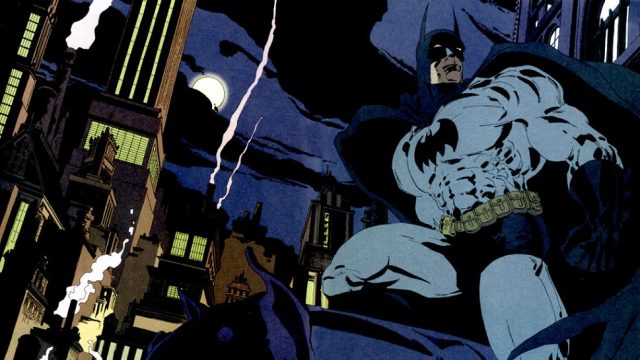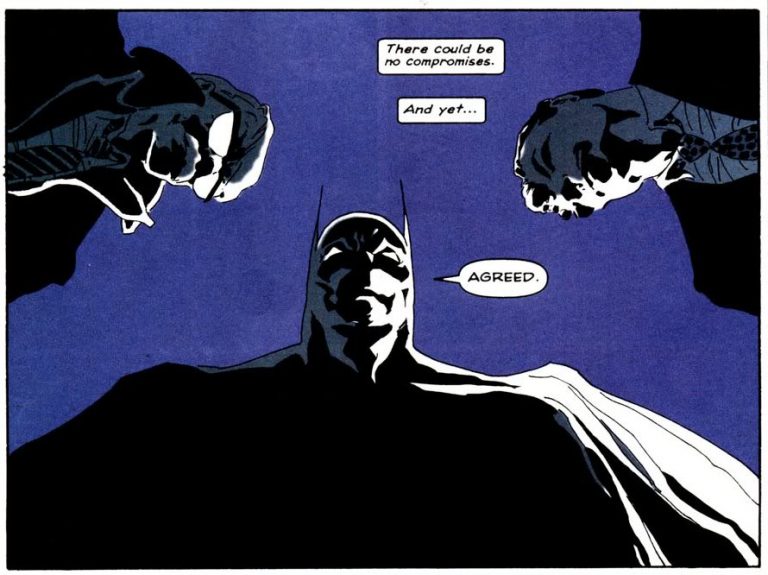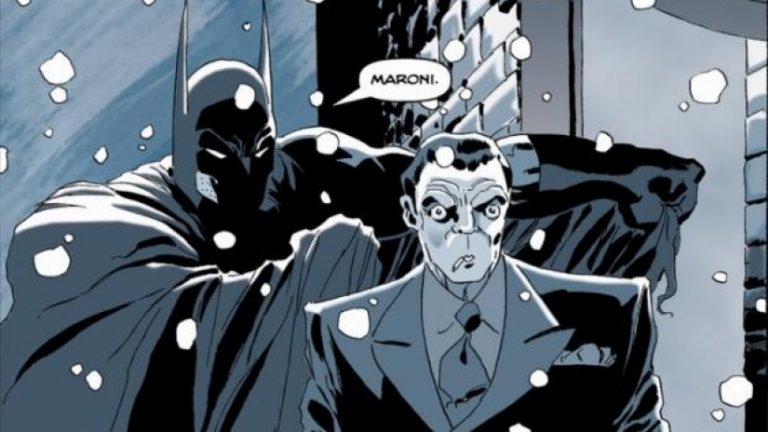I think you can split Batman stories into three branches by tone. First off you have the ultra-dark work of Frank Miller in The Dark Knight Returns, part of the grim-and-gritty phase of comics in the late ‘80s and ‘90s, where everything is ever so serious and Theme with a capital T is very important, like how Batman and Joker are opposites that attract (I think you can probably tell if you’ve been reading my work here that a little of this can go a long way for me). Then you have something like Batman: Brave and the Bold, the animated series starring Diedrich Bader as Batman that leaned into the goofy, fun history of the character (and boy, is there a lot to lean into).
The third way…that’s where we get something like Batman: The Long Halloween. Sure, there is Theme (and we’ll get back to that) but it’s a middle path between that and the inherent goofiness of a story involving a crazy man in a batsuit chasing people in colorful costumes.
One of the things I like about this particular Batman story is how it’s more about the crime families of Gotham than about any supervillain trying to take over the city or even to kill the Batman. Starting on Halloween, once a month on a holiday a member of the Falcone family or someone associated with them is being murdered and a trinket signifying the holiday left with their corpse. Batman is racing against time to stop the killing before an all-out gang war starts between Falcone and the rival Maroni family who he blames for the murders. To take down the killer and also the Falcone family, legally, Batman has to ally with one more person than his usual contact, Captain James Gordon.
Harvey Dent.
Now, let’s step back here a second and look at how important this book ends up being in the wider Batman mythos, not just the comics. The Long Halloween is set before Harvey becomes Two-Face, the tragic end to Harvey’s dedication to justice mangled into a flip of the coin. This is still the brash and somewhat idealistic Harvey, trying to bring justice to Gotham. How he becomes Two-Face in this is a huge influence on the Christopher Nolan Batman trilogy. Nolan (and screenwriter David S. Goyer) are actually interviewed for the introduction to the current paperback and absolute editions of The Long Halloween, and they talk about how the triumvirate of the cop, the DA and the Batman was their central cornerstone for Batman Begins (using Rachel Dawes instead of Dent for that movie; amusingly, this conversation takes place between Begins and The Dark Knight going into production and they talk about considering Harvey Dent for The Dark Knight and not going on with that – I wonder if they were just throwing up a smoke screen there). You have to wonder, without this book, does Two-Face become as important as he does in the popular perception of Batman?
Now here’s where that nasty little Theme talk I mentioned starts coming in (I’ll keep it short). These three men, coming together to stop a gang war and bring down a criminal empire, all know they can’t do it alone. What happens when you start suspecting one of your triumvirate may actually be the problem? Is Harvey Dent committing extrajudicial murders? Is Dent right in thinking there is something screwy with Bruce Wayne, whose father had connections to the Falcone family back in the day? What’s Gordon to do when he’s not quite sure how much he can trust either the overzealous DA or a man in a bat costume? The shift back and forth between the three of them is one of the joys of the book, even as one of them collapses and goes off the rails.
The only problem I have with the story, really, is the conclusion as to who the Holiday Killer actually is. It’s entirely possible that there were up to three killers and at least one of them I feel comes a little bit out of nowhere. It’s been a sore spot for me in the 21 years since this book came out and it’s this little thing that I’ve never been able to quite reconcile myself to. Some say it’s the little grit in the oyster that makes the pearl all the better, but this one just gnaws at me when I think about the book.
All of this might not work even half as well without Tim Sale’s pencils (he is also credited for the story with Jeph Loeb) and Gregory Wright’s coloring. This book is incredibly dynamic, even when you’re simply looking at figure standing and speaking. Sale does wonderful work in body and expression and for a man who’s color blind he has an excellent talent for pencils that can be colored beautifully. (Also, an amazing level of detail in his work; his Poison Ivy is practically swimming with greenery and it’s my favorite version of the character.) Sometimes his characters can verge on the level of caricature, being slightly too beefy or slightly too scrawny, but he never crosses that line and it’s a wonderful expression of the middle ground of Batman stories that they are telling here.
I haven’t read all or even the majority of Batman comics that have been published over the last 79 years, but I think I can pretty safely say that The Long Halloween is one of those stories that towers over the others. It’s a huge piece of work that nevertheless is also wonderfully focused; where something like Batman: No Man’s Land a year after this would be a sprawling epic with many different storylines (and at times an almost shocking lack of Batman), this story focused on essentially three people (but with guest appearances by most of Batman’s rogue gallery) is an achievement. It strips down what a Batman story should be to its bare bones and builds what is really a crown for the Batman mythos, one everyone involved with can look at with pride.




